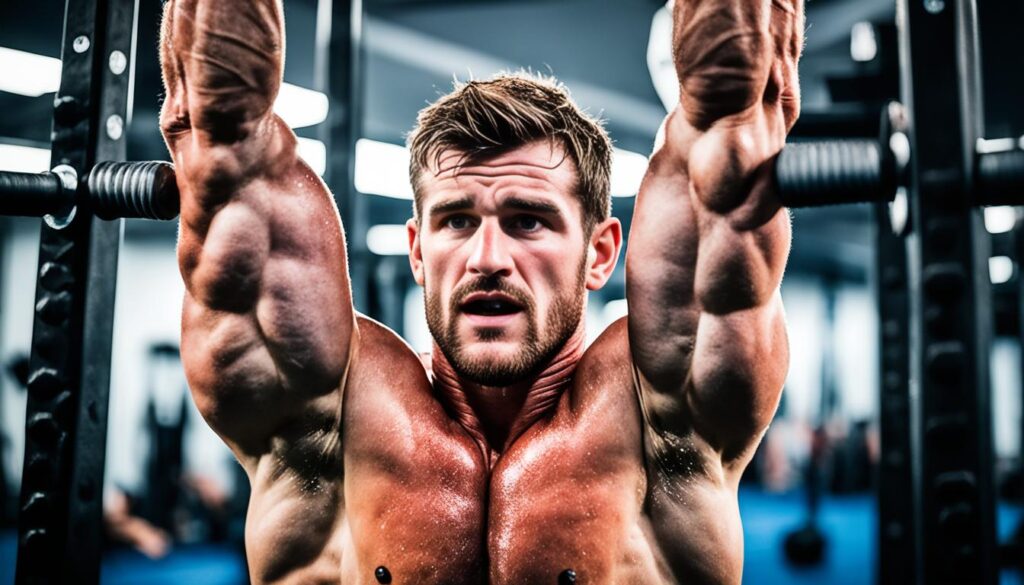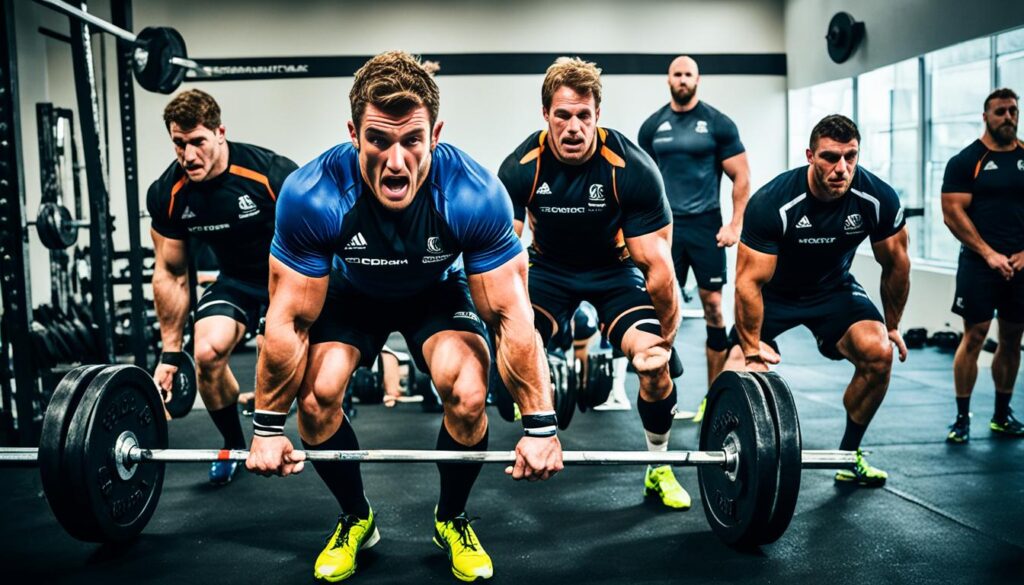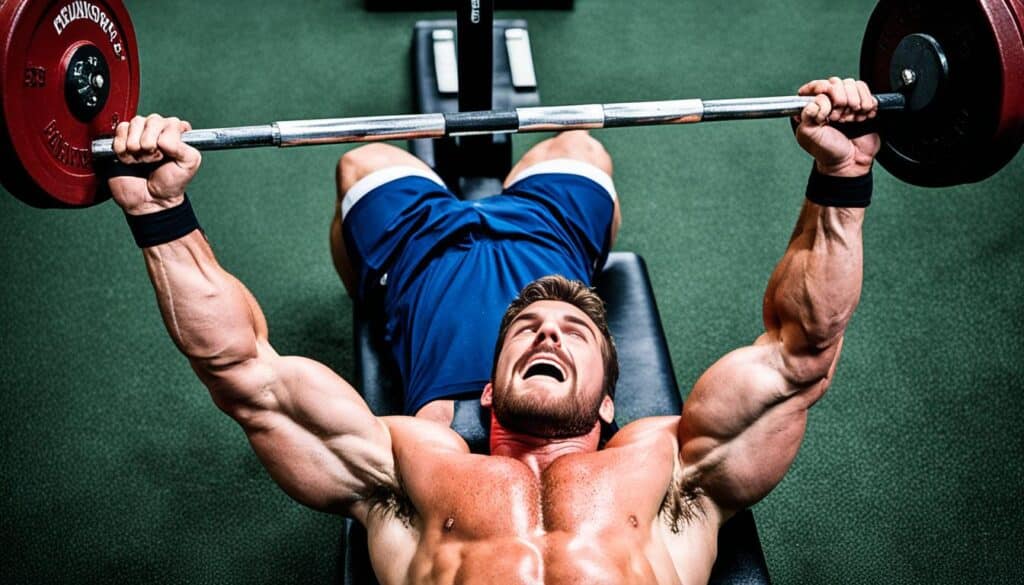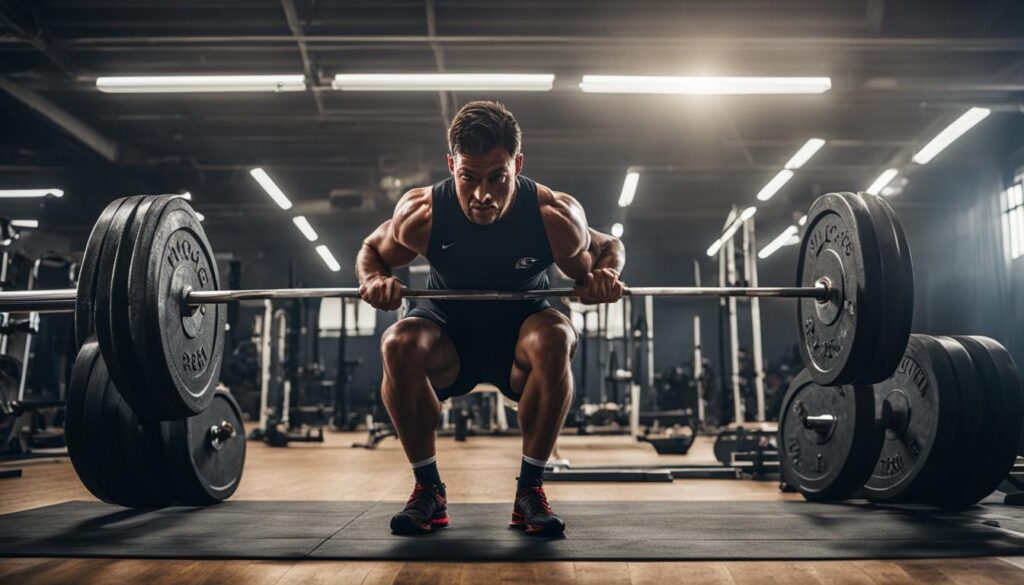Rugby players are renowned for their exceptional physical abilities, dedicated training routines, and unique lifestyle. These elite athletes possess extraordinary strength, power, agility, and stamina, making them stand out in the world of sports.
Muscle development plays a crucial role in the performance of professional rugby players, providing both strength and protection during intense collisions on the field. To build a physique similar to these elite athletes, a specialized training approach is needed. Functional hypertrophy training, focusing on compound exercises such as squats, deadlifts, and chin-ups, is recommended to sculpt a powerful and resilient physique. Modified strongman training can also be incorporated to further enhance overall strength, power, and mobility.
Key Takeaways:
- Elite rugby players possess exceptional strength, power, agility, and stamina.
- Building muscle is essential for protection and optimal performance on the field.
- Functional hypertrophy training and modified strongman training are recommended for rugby players.
- Compound exercises like squats, deadlifts, and chin-ups should be the core of the workout routine.
- Rugby players should prioritize strength training while also focusing on all-around fitness.
The Importance of Muscle in Rugby
Muscle acts as a protective armor for rugby players during matches. The physical demands of the game include absorbing collisions comparable to car crashes. In a typical test match, players cover an average of 9km and experience more than 400 impacts greater than 9G per match. To put this into perspective, a space shuttle launch generates 3G, and a car crash at 40mph generates 35G. Building muscle is essential for withstanding these high-impact forces and ensuring the player’s safety on the field.
| The Impact of Rugby Collisions | |
|---|---|
| Distance Covered per Match | 9km |
| Impacts Greater than 9G per Match | 400+ |
| Space Shuttle Launch | 3G |
| Car Crash at 40mph | 35G |
Training for the Rugby Look

To achieve the desired rugby player physique, training should focus on functional hypertrophy, a training method that combines muscle building with functionality. Compound lifts such as squats, deadlifts, and chin-ups should form the core of your workout routine. These exercises engage multiple muscle groups simultaneously, promoting overall strength and power.
During your training sessions, aim to perform six to ten reps per set. Emphasize controlled movements and tense muscle contractions to maximize muscle development. It’s important to maintain proper form and technique to avoid injury and achieve optimal results.
In addition to compound lifts, incorporating assistance exercises into your routine can further enhance muscle development. Some effective assistance exercises for rugby players include lunges, shoulder presses, kettlebell swings, and abs exercises. These exercises target specific muscle groups and provide additional support for overall muscle building.
Focusing on Compound Lifts
Compound lifts are fundamental exercises that engage multiple muscle groups and promote functional strength and muscle building. Here are the key compound lifts recommended for rugby players:
| Exercise | Muscle Groups Targeted |
|---|---|
| Squats | Quadriceps, hamstrings, glutes, calves, core |
| Deadlifts | Hamstrings, glutes, lower back, core, upper back, traps |
| Chin-ups | Latissimus dorsi, biceps, brachialis, upper back, shoulder stabilizers |
These compound lifts provide a solid foundation for building overall strength and power, targeting the muscles necessary for rugby performance.
Assistance Exercises to Enhance Muscle Development
In addition to compound lifts, assistance exercises can be incorporated into your training routine to further enhance muscle development. Here are some effective assistance exercises for rugby players:
- Lunges: Targeting the quadriceps, hamstrings, and glutes, lunges help improve lower body strength and stability.
- Shoulder Presses: Focusing on the deltoids, triceps, and upper back, shoulder presses enhance upper body strength and power.
- Kettlebell Swings: Working the posterior chain, including the glutes, hamstrings, and lower back, kettlebell swings improve explosive power.
- Abs Exercises: Core strength is essential for stability and power on the rugby field. Incorporate exercises like planks, Russian twists, and hanging leg raises to strengthen your core.
By incorporating compound lifts and assistance exercises into your training routine, you can effectively build muscle and achieve the desired rugby player physique. Remember to focus on proper form, controlled movements, and gradually increasing weights to continually challenge your muscles and stimulate growth.
Modified Strongman Training for Rugby Players

Modified Strongman Training (MST) is a highly effective method for developing functional strength, power, and endurance in rugby players. This training approach incorporates a variety of exercises that replicate the physical demands of rugby, providing a comprehensive full-body workout.
MST exercises include log presses, yoke carries, and Atlas stone lifts, among others. These movements engage multiple muscle groups simultaneously, helping to improve overall strength and power.
One of the key characteristics of MST is its high intensity and volume. Rugby players engaging in this type of training can expect short rest periods and a significant workload, mirroring the demands of a game on the field.
Common equipment used in MST includes tires, prowlers, sleds, and medicine balls. These tools provide the necessary resistance and challenge to push rugby players’ physical limits.
Benefits of Modified Strongman Training for rugby players:
- Improved functional strength: MST targets various muscle groups simultaneously, helping rugby players develop full-body strength that translates directly to game performance.
- Enhanced power: The explosive nature of MST exercises, such as yoke carries and Atlas stone lifts, improves a player’s power output, enabling them to generate more force during tackles and sprints.
- Increased endurance: MST involves high-intensity training with short rest periods, allowing players to improve their cardiovascular efficiency and stamina.
- Burns fat reserves: The combination of intense workouts and full-body movements in MST helps players shed excess body fat, enhancing their agility and overall performance.
Sample Modified Strongman Training Routine
Here’s an example of a Modified Strongman Training routine that rugby players can incorporate into their strength and conditioning program:
Exercise 1: Log Press
- 3 sets of 8 reps
- Rest: 90 seconds between sets
Exercise 2: Yoke Carries
- 4 sets of 40 yards
- Rest: 2 minutes between sets
Exercise 3: Atlas Stone Lifts
- 5 sets of 5 reps
- Rest: 90 seconds between sets
Exercise 4: Tire Flips
- 3 sets of 10 flips
- Rest: 2 minutes between sets
Remember to warm up adequately before starting the routine and always prioritize proper form and technique to prevent injuries.
Modified Strongman Training provides rugby players with a unique and challenging full-body workout that enhances functional strength, power, and endurance. By incorporating MST into their training regimen, rugby players can develop the physical capabilities necessary for success on the field.
The Strength of Rugby Players: Squatting

Squatting is an essential exercise for rugby players looking to build strength and power in their lower body. Considered the “king of exercises,” the back squat is highly effective in developing muscle mass and enhancing overall strength.
Professional rugby players, known for their remarkable physical abilities, often impress even powerlifters with their squatting prowess. On average, male backs can squat weights around 209kg (459.8 lb), while male forwards can handle weights around 195.25kg (429.55 lb). Female backs and forwards also demonstrate impressive squatting strength, albeit at slightly lower average weights compared to their male counterparts.
The benefits of squatting extend beyond just pure strength. This compound exercise engages multiple muscle groups, including the quadriceps, hamstrings, glutes, and core, promoting functional strength and stability.
Squatting not only enhances performance on the field but also contributes to injury prevention by strengthening the lower body’s muscles and connective tissues. The ability to generate power from the ground up is crucial for rugby players, allowing them to excel in explosive movements such as tackling, running, and evading opponents.
“Squatting is an essential exercise for rugby players, as it targets major muscle groups and develops functional strength necessary for the physical demands of the game.”
Proper Squat Technique
To execute squats effectively and safely, proper technique is crucial:
- Start with a stable stance: Position your feet shoulder-width apart, toes slightly turned out.
- Maintain an upright torso: Keep your chest lifted and your head in line with your spine throughout the movement.
- Initiate the squat: Hinge at your hips, then bend your knees, lowering your body down as if you are sitting back into a chair.
- Keep your knees aligned: Ensure that your knees track in line with your toes, avoiding inward collapse or excessive outward movement.
- Reach adequate depth: Aim to squat until your hips are parallel with or slightly below your knees, maintaining proper form.
- Drive through your heels: Push the floor away while engaging your glutes and leg muscles to return to the starting position.
Remember, focusing on maintaining good form throughout each squat repetition is crucial for optimizing results and minimizing the risk of injury.
Squatting as a Strength Measurement
The amount of weight a rugby player can squat is often used as an indicator of their lower body strength and overall physical power. It is commonly assessed by measuring the player’s one-repetition maximum (1RM) in the back squat.
While impressive squat weights are achieved by elite rugby players, it’s important to note that specific training goals and individual variations can influence their performance. Nonetheless, squatting remains an integral part of strength development and conditioning for rugby players.
The average squat weights for rugby players:
| Rugby Position | Average Squat Weight (Male) |
|---|---|
| Backs | 209kg (459.8 lb) |
| Forwards | 195.25kg (429.55 lb) |
Note: Female rugby players also possess remarkable squatting strength, although the average weights may be slightly lower compared to male players.
The Strength of Rugby Players: Bench Press

The bench press is a classic test of upper body strength and plays a crucial role in rugby player performance. The muscles targeted during the bench press, including the pectoralis major, deltoids, and triceps, are vital for pushing opponents and defending against tackles.
Male backs have an average bench press 1RM of 100.5kg (251.25 lb), while male forwards have an average of 95kg (209 lb). Female backs and forwards, on average, have lower bench press 1RM scores. Although bench press performance is important, rugby players also need to focus on overhead strength and overall functional upper body power.
Rugby Bench Press Average 1RM
| Position | Average 1RM (Male) | Average 1RM (Female) |
|---|---|---|
| Backs | 100.5kg (251.25 lb) | 75kg (165.35 lb) |
| Forwards | 95kg (209 lb) | 70kg (154.32 lb) |
Importance of Strength Training for Rugby Players
Strength training is a critical component of a rugby player’s training routine. It plays a vital role in enhancing overall performance on the field, enabling players to excel in strength, power, endurance, and functional capabilities. Incorporating compound exercises into the training program is key to developing the necessary strength required for successful gameplay.
Compound exercises, such as squats, deadlifts, bench presses, and overhead presses, engage multiple muscle groups simultaneously. This engagement not only promotes muscle growth but also improves coordination, stability, and overall functional strength. By regularly performing these exercises, rugby players can develop a well-rounded physique that can withstand the physical demands of the game.
Progressive overload is essential in strength training. It involves gradually increasing the weights used during exercises to continuously challenge the muscles and stimulate further growth and adaptation. In addition to increasing weights, focusing on low reps with heavy weights is crucial for strength gains. This training approach helps build a solid foundation of strength that translates into improved performance on the field.
Allowing ample rest between sets is equally important as it allows the muscles to recover and adapt to the stress imposed on them. Adequate rest periods ensure that the muscles can generate maximum force during subsequent sets, contributing to enhanced strength gains over time.
Strength training not only increases muscle size and power but also positively impacts endurance. Strong muscles can sustain intense efforts for longer periods, allowing rugby players to maintain high performance levels throughout matches.
The table below highlights some of the compound exercises commonly utilized in rugby player strength training:
| Compound Exercises | Targeted Muscle Groups |
|---|---|
| Squats | Quadriceps, Hamstrings, Glutes, Calves, Core |
| Deadlifts | Hamstrings, Glutes, Lower Back, Core, Forearms, Grip Strength |
| Bench Presses | Chest, Triceps, Front Deltoids, Core |
| Overhead Presses | Deltoids, Triceps, Trapezius, Core |
By incorporating these compound exercises into their training routine, rugby players can develop the necessary strength and functional capabilities to excel in their sport. It is important to consult with a qualified strength and conditioning coach to design a tailored training program that meets individual needs and goals.
Building Strength in Rugby: Training Guidelines

Rugby players aiming to enhance their performance on the field should prioritize strength training. Building overall strength is crucial for withstanding the intense physical demands of the game. By incorporating compound exercises, low reps, heavy weights, and adequate rest, rugby players can maximize their strength gains and develop the power needed to dominate the field.
Compound Exercises for Building Strength
Compound exercises are key to building strength in rugby players. These exercises engage multiple muscle groups simultaneously, allowing players to develop functional strength that translates directly to their performance on the field. Some effective compound exercises include:
- Squats
- Deadlifts
- Bench Presses
- Overhead Presses
These exercises target major muscle groups, such as the legs, back, chest, and shoulders, enabling rugby players to build overall strength and power.
Low Reps and Heavy Weights
Rugby players should focus on training with low reps and heavy weights to maximize strength gains. Low reps, typically in the range of 1-5, allow players to lift heavier weights, stimulating muscular adaptation and promoting strength development. By challenging their muscles with heavy weights, rugby players can build the strength needed to outperform their opponents on the field.
Optimal Rest and Recovery
Rest and recovery play a crucial role in strength training for rugby players. To optimize performance and prevent injury, players should allow sufficient rest periods between sets, typically 3-5 minutes. This allows the muscles to fully recover and perform at their best during subsequent sets. Adequate sleep, a balanced diet, and a healthy lifestyle are also essential for supporting strength development and overall well-being.
Gradual Weight Progression
Gradually increasing the weights lifted over time is vital for continuous strength improvement. Rugby players should aim to progressively overload their muscles by gradually adding more weight as their strength and technique improve. This progressive approach to weightlifting ensures consistent gains in strength, enabling players to reach their full potential.
| Type of Exercise | Reps | Weight | Rest |
|---|---|---|---|
| Squats | 3-5 | 85% or more of 1RM | 3-5 minutes |
| Deadlifts | 3-5 | 85% or more of 1RM | 3-5 minutes |
| Bench Presses | 3-5 | 85% or more of 1RM | 3-5 minutes |
| Overhead Presses | 3-5 | 85% or more of 1RM | 3-5 minutes |
These guidelines provide a basic framework for rugby players looking to build strength. It is important to consult with a qualified strength and conditioning coach to tailor the training program to individual needs and goals. By following these training guidelines, rugby players can develop the strength necessary to excel on the field and outperform their opponents.
The Importance of All-Around Fitness in Rugby

Rugby requires a high level of all-around physical fitness, including speed, power, endurance, agility, coordination, and flexibility. Unlike some other sports that require specialization in specific fitness components, rugby demands a comprehensive approach to training.
Players need to incorporate exercises and drills that target each of these fitness components. Improving speed enables players to outrun opponents, while enhancing power and endurance contributes to strength and stamina during matches. Agility and coordination help with quick movements and effective gameplay, and flexibility prevents injuries and improves overall performance on the field.
Rugby players must develop a balance of physical abilities, allowing them to excel in multiple aspects of the game. The combination of speed, power, endurance, agility, coordination, and flexibility creates a well-rounded athlete capable of performing at a high level.
The Basics of Getting Stronger for Rugby
To enhance your strength for rugby, incorporating proper strength training techniques is essential. By focusing on compound exercises, gradually increasing weights, and prioritizing recovery, you can maximize your strength gains and perform at your best on the field.
Compound exercises form the foundation of strength training for rugby players. Exercises like squats, deadlifts, and bench presses engage multiple muscle groups, resulting in overall strength development. These exercises simulate the movements required in the game and provide functional strength that directly translates to improved performance.
When performing strength training exercises, work with heavy weights and aim for low reps in the 1-5 range. This intensity helps stimulate muscle growth and strength gains. As you become more comfortable with the weights, gradually increase the load to continue challenging your muscles and promoting progress.
Rest and recovery are equally important in the strength training process. Allow sufficient rest between sets to give your muscles time to recover and adapt to the stimulus. This rest period can vary depending on the exercise and your individual needs, but generally, a 2-3 minute rest between sets is recommended.
In addition to rest, nutrition plays a vital role in muscle development and strength gains. Ensure you have an adequate intake of protein to support muscle growth and repair. Protein sources like lean meats, poultry, fish, eggs, and plant-based options such as beans, lentils, and tofu are excellent choices for rugby players. Remember to maintain a balanced diet that includes a variety of nutrient-rich foods to meet all your nutritional needs.
Recovery goes beyond nutrition and extends to sleep and lifestyle choices as well. Aim for 7-9 hours of quality sleep each night to allow your body to recover and repair. Avoid excessive consumption of junk food and alcohol, as these can negatively impact your training and recovery. Listen to your body and prioritize rest days or active recovery sessions to prevent overtraining and reduce the risk of injury.
It’s crucial to adjust your training intensity based on the competitive season. During the off-season, when there are no matches, focus on harder workouts to build strength and push your limits. As the playing season approaches, reduce the volume of your training to allow for adequate recovery and ensure you’re fresh for each game.
| Key Points: |
|---|
| Focus on compound exercises like squats, deadlifts, and bench presses. |
| Increase weight gradually to continue challenging your muscles. |
| Allow sufficient rest between sets and prioritize recovery. |
| Ensure proper nutrition with an adequate intake of protein. |
| Maintain a balanced diet, get enough sleep, and avoid excessive junk food and alcohol. |
| Adjust training intensity based on the competitive season. |
By following these basic principles of strength training, you can optimize your physical performance, enhance your strength, and excel as a rugby player.
Wrapping Up: The Strength of Rugby Players
Rugby players are renowned for their exceptional strength and physical capabilities. Strength training is a vital component in developing the power, endurance, and resilience necessary for successful gameplay. Two key exercises that measure and enhance strength in rugby players are squatting and bench pressing.
Nevertheless, it is crucial to recognize that rugby is a multi-dimensional sport that demands a comprehensive approach to fitness. While building strength is important, players must also focus on other components such as speed, agility, endurance, and overall fitness. By finding the right balance between strength training, skill development, and tactical training, rugby players can achieve optimal performance on the field.
Table: Rugby Player Strength Metrics
| Rugby Player Position | Average Squat Weight (1RM) | Average Bench Press Weight (1RM) |
|---|---|---|
| Male Backs | 209kg (459.8 lb) | 100.5kg (251.25 lb) |
| Male Forwards | 195.25kg (429.55 lb) | 95kg (209 lb) |
| Female Backs | Lower average weights | Lower average weights |
| Female Forwards | Lower average weights | Lower average weights |
Table: Rugby Player Strength Metrics
| Rugby Player Position | Average Squat Weight (1RM) | Average Bench Press Weight (1RM) |
|---|---|---|
| Male Backs | 209kg (459.8 lb) | 100.5kg (251.25 lb) |
| Male Forwards | 195.25kg (429.55 lb) | 95kg (209 lb) |
| Female Backs | Lower average weights | Lower average weights |
| Female Forwards | Lower average weights | Lower average weights |
Strength is undoubtedly a crucial attribute, but all-around fitness is equally important for rugby players. Speed, agility, endurance, coordination, and flexibility contribute to overall performance on the field. By incorporating specific exercises and drills targeting each fitness component, rugby players can enhance their speed, power, stamina, and game awareness.
When it comes to rugby, there’s no shortage of exceptional talent gracing the international stage. From prop forwards to scrum-halves, the world of professional rugby boasts some of the best players in the sport. Names like South African’s Siya Kolisi, Welsh legend Alun Wyn Jones, and Australian David Pocock have left indelible marks on the game. These players showcase not only incredible skill but also remarkable body strength and tactical prowess.
Whether it’s dominating in the scrum, making bone-crunching tackles, or executing precision kicks, these athletes exemplify the high level of competition seen in tournaments like the Six Nations, Rugby Championship, and Super Rugby. With world cups, test series, and championships like the Champions Cup and Currie Cup, rugby players from different countries have ample opportunities to showcase their talents and vie for titles. As rugby continues to captivate audiences worldwide, the sport’s top players continue to push boundaries and redefine what it means to be a champion on the rugby field.
Also Read : Ultimate Guide To Water Sports Adventures
Conclusion
Strength training is an essential aspect of developing rugby players, contributing to their overall performance on the field. By incorporating compound exercises like squats, deadlifts, and bench presses, players can build exceptional strength and power. Progressive overload, by increasing weights over time, is key to continuous improvement. However, strength alone does not guarantee success in rugby.
An all-around fitness approach is crucial for rugby players to excel in the game. Speed, endurance, agility, and coordination must be developed alongside strength training. Emphasizing skill development and tactical training complements the physical attributes gained through strength training, resulting in well-rounded, high-performing rugby players.
By striking the right balance between strength training and all-around fitness, rugby players can enhance their performance on the field. Working on functional strength, power, and endurance, while also focusing on speed, agility, and coordination, will produce the ideal physical and mental capabilities required to dominate the game of rugby.
FAQs
Q: What are the essential training routines for elite rugby players?
A: Essential training routines for elite rugby players include strength and conditioning exercises, speed and agility drills, as well as skill-specific training such as tackling, passing, and lineouts.
Q: How do elite rugby players maintain their fitness levels during the off-season?
A: Elite rugby players maintain their fitness levels during the off-season through carefully structured training programs that focus on maintaining strength, endurance, and agility while allowing for adequate rest and recovery.
Q: What are the key skills that elite rugby players need to excel on the field?
A: Elite rugby players need to excel in skills such as tackling, passing, kicking, decision-making, and game awareness. These skills are essential for success in the highly competitive environment of professional rugby.
Q: What are some lifestyle factors that elite rugby players need to consider to maintain peak performance?
A: Lifestyle factors such as nutrition, rest, mental well-being, and injury prevention are crucial for elite rugby players to maintain peak performance on and off the field.
Q: How do elite rugby players balance their professional careers with personal life?
A: Elite rugby players balance their professional careers with personal life by managing their time effectively, seeking support from family and friends, and prioritizing rest and recovery to maintain a healthy work-life balance.
Q: What are the major rugby news sources that elite rugby players follow to stay updated?
A: Elite rugby players often follow major rugby news sources such as World Rugby, Super Rugby, and national rugby union websites to stay updated with the latest developments in the sport.
Q: What are the most renowned rugby-playing nations in the world?
A: New Zealand, South Africa, France, Ireland, Wales, Scotland, Argentina, Fiji, and Samoa are among the most renowned rugby-playing nations in the world, known for producing top-tier rugby talent.
Q: Who are considered the best rugby players in the world currently?
A: The best rugby players in the world are often determined based on their performance in international competitions, such as the Six Nations Championship, Rugby World Cup, and domestic leagues including the Premiership, Top 14, and Super Rugby.
Q: What are the upcoming major events in the world of rugby?
A: The upcoming major events in the world of rugby include the 2023 Rugby World Cup and the ongoing regional tournaments such as the Six Nations Championship and Super Rugby.
Q: Where can I find a transcript of recent rugby-related interviews and discussions?
A: Transcripts of recent rugby-related interviews and discussions can often be found on official rugby union websites, major sports news platforms, and associated social media channels.





